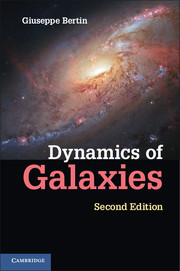Book contents
- Frontmatter
- Contents
- Preface to the Second Edition
- Preface to the First Edition, 2000
- Acknowledgments
- PART I Basic Phenomenology
- PART II Physical Models
- 6 Self-Gravity and Relation to Plasma Physics
- 7 Relaxation Times, Absence of Thermodynamical Equilibrium
- 8 Models
- 9 Equilibrium and Stability: Symmetry and Symmetry Breaking
- 10 Classical Ellipsoids
- 11 Introduction to Dispersive Waves
- 12 Jeans Instability
- PART III Spiral Galaxies
- PART IV Elliptical Galaxies
- PART V In Perspective
- Bibliography
- Index of objects
- Index
7 - Relaxation Times, Absence of Thermodynamical Equilibrium
from PART II - Physical Models
Published online by Cambridge University Press: 05 June 2014
- Frontmatter
- Contents
- Preface to the Second Edition
- Preface to the First Edition, 2000
- Acknowledgments
- PART I Basic Phenomenology
- PART II Physical Models
- 6 Self-Gravity and Relation to Plasma Physics
- 7 Relaxation Times, Absence of Thermodynamical Equilibrium
- 8 Models
- 9 Equilibrium and Stability: Symmetry and Symmetry Breaking
- 10 Classical Ellipsoids
- 11 Introduction to Dispersive Waves
- 12 Jeans Instability
- PART III Spiral Galaxies
- PART IV Elliptical Galaxies
- PART V In Perspective
- Bibliography
- Index of objects
- Index
Summary
Empirical evidence proves that stellar systems do not obey the simple laws of equilibrium thermodynamics. For example, in the solar neighborhood, the data show that the distribution of stellar orbits is such that the associated pressure tensor is definitely anisotropic, which is a primary indication of insufficient relaxation; the axis ratios of the velocity ellipsoid for old disk stars are approximately cr: cθ: cz = 39: 23: 20 (the pressure ratios go with the square of these figures).
In this chapter an elementary discussion is given of why large stellar systems are characterized by a very low degree of collisionality, and then the issue of how such collisionless stellar systems can still be subject to relaxation processes that play a significant role in their evolution is briefly addressed. Thus, even if stellar encounters act on a very long time scale, arbitrary distributions of stellar orbits are probably not realized in nature. It appears that, also with the help of subtle mechanisms of collisionless relaxation, most normal galaxies are in a slowly evolving state of incomplete relaxation.
Two-Star Relaxation Times
The following discussion summarizes well-known results that apply to stellar systems and ionized gases. The two-star relaxation times quantify the effects of star-star collisions in changing the orbit of a star with respect to that determined by the smooth mean field generated by the whole stellar system. Here the stars are considered as point masses interacting with each other according to Newton's law. The relaxation times thus measure the effects of the discreteness of the mass distribution in a stellar system.
- Type
- Chapter
- Information
- Dynamics of Galaxies , pp. 66 - 81Publisher: Cambridge University PressPrint publication year: 2014



